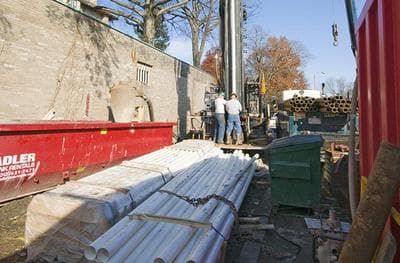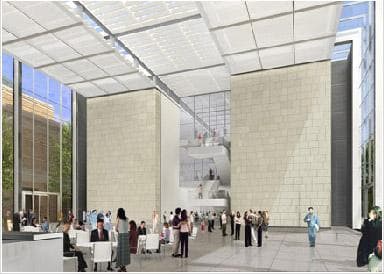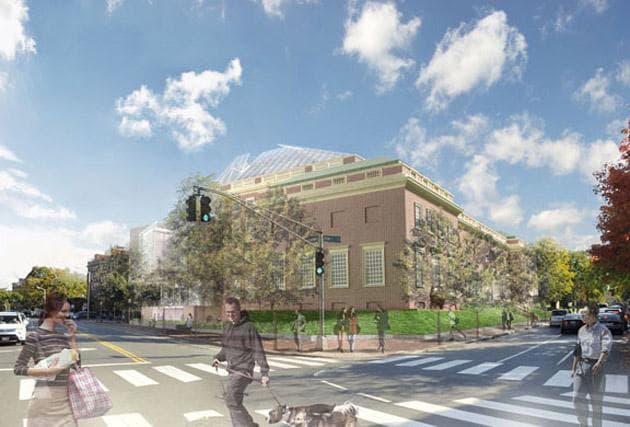Advertisement
The Art Of Going Green In The Museum
ResumeA rare convergence is happening in Boston. Right now, three major art museums are undergoing major expansion projects. And all of them — the Isabella Stewart Gardner Museum, the Museum of Fine Arts and the Harvard Art Museum — are going "green." But not without trepidation.
We all know the line: it isn’t easy being green. But for art museums, going green can actually be scary.
The Isabella Stewart Gardner Museum

It's messy and loud outside the Isabella Stewart Gardner Museum. Men in scoop trucks are digging eight geothermal wells. The wells are 1,500 feet deep, cost about $300,000 and will efficiently heat and cool the Gardner’s new 70,000-square foot building.
Which brings us to the scary part. Climate control is a touchy topic in the art world. It puts curators, conservationists and directors on edge. For good reason.
Video: Pouring Of The Mat Slab
Sitting in a gallery, surrounded by priceless furniture and paintings, Hawley describes an art museum nightmare –- the result if galleries aren’t kept at a constant temperature of 65 to 70 degrees, and humidity around 50 percent.
"You get flaking of paints from the surfaces," she described. "So many of the materials used in making art are materials that are not unlike our own bodies, you know, they have a life."
Hawley says art preservation is a race against time. It also consumes gobs of energy. And that creates a conflict, pitting going green against preservation. So how does a museum take care of precious cargo while reducing its carbon footprint?
Museum Of Fine Arts
"We’re trying to find a balance, we’re not there yet," says Matthew Siegel, chairman of conservation and collections management at the Museum of Fine Arts.
Siegel is responsible for all 400,000 objects held by the museum. Speaking over the drone of the ventilation system in the museum’s basement, Siegel says the MFA’s $500 million expansion project is forcing him to think green.

"The way we operate now we recognize is really not sustainable," he says, "and we’re all working towards trying to find sustainable practices in everything that we do."
For instance, Siegel designed re-usable crates for storing art.
But to give you an idea of how unsustainable museum practices can be, I venture into a part of the MFA where — they tell me — no reporter has ever gone before: the boiler room.
This is David Geldart’s domain. He’s the MFA’s director of facilities, and he shows me a huge new chiller that helps keep the MFA’s main building cool and moist. Even with the update, though, Geldart says the museum burns about 12 million kilowatt hours of electricity a year.
"The majority of it is on cooling, and the rest is on lighting," he explains, "so the new high-efficiency chiller with a variable speed drive and new controls on it saved us roughly about 60,000 kilowatt hours a year." Which, Geldart tells me, translates to more than $40,000 a year.
Think about that for a second. They save $40,000. How much do you pay for electricity a year?
MFA engineers predict high-tech climate control and lighting in the new wing will reduce costs and usage even more.
Harvard Art Museum

Over at the Harvard Art Museum, Jackie Henke says there are countless shades of green. As sustainability manager, she’s overseeing the renovation and expansion of the Fogg, Busch-Reisinger and Arthur M. Sackler Museums.
She ticks off some of those shades of green for me: "Water efficient landscaping, we’re not using potable water for irrigation, we are going to divert construction waste from landfills, we are using recycled content materials, some materials are sourced locally."
Henke insists art museums have nothing to fear by going green. In fact, she says updating and preserving a building for the long-haul is tantamount to preserving the priceless pieces inside.
Across the river at the Gardner Museum Director Anne Hawley agrees. "If you’re a public institution, you intend your buildings to last for hundreds of years," she says. "I hope the Gardner Museum is around in 800 years, and I hope that the geothermal wells will still be pumping."
Those geothermal wells are slated to start pumping by early 2012.
This program aired on February 4, 2010.
